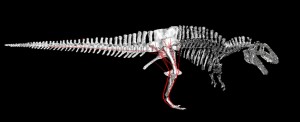Hirohisa Aoshima have fixed a bug (an issue on python-twitter when fetching more than 100 users) on Twitter 3D visualization tool and made another video (the blog is in Japanese). Here is the link direct to the video on YouTube.
From the article of LiveScience.com:
The pick and shovel can go only so far in digging up details about dinosaurs. Now supercomputers are revealing knowledge about their anatomy otherwise lost to history.
(…)
For example, if the muscles connected to the thigh bone of a Tyrannosaurus rex were short, that would suggest it was angled vertically as in humans. However, if they were very long, it could have been angled horizontally as in birds.
Initial attempts to randomly decipher which pattern of muscle activation works best result almost always in the animal falling on its face, explained computer paleontologist Peter Falkingham at the University of Manchester. But the scientists employ “genetic algorithms,” or computer programs that can alter themselves and evolve, and so run pattern after pattern until they get improvements.
Eventually, they evolve a pattern of muscle activation with a stable gait and the dinosaur can walk, run, chase or graze, Falkingham said. Assuming natural selection evolves the best possible solution as well, the modeled animal should move similar to its now extinct counterpart. Indeed, they have achieved similar top speeds and gaits with computer versions of humans, emus and ostriches as in reality.
Read the full article.
There is a portuguese version of this post.
Evolutionary computing (EC) has been widely used in recent years, and every year there are new applications for the techniques developed, despite being a relatively new area, few people are giving attention to that (at least in my vision and I will explain why) probably will have a promising and revolutionary future in relation to how we can generate innovation and even learn from it, especially as it relates to Evolutionary Algorithms (EAs).
A Computação Evolutiva (EC) tem sido sido muito utilizada nos últimos anos, e a cada ano que passa, surgem novas aplicações para as técnicas desenvolvidas; apesar de ser uma área relativamente nova, pouca gente está dando a devida atenção ao que (ao menos na minha visão, e vou explicar porque) provavelmente terá um futuro promissor e revolucionário em relação à como podemos gerar a inovação a até mesmo aprender com ela, principalmente no que se relaciona com Algoritmos Evolutivos (EAs).
From the Wired article:
Initially, the equations generated by the program failed to explain the data, but some failures were slightly less wrong than others. Using a genetic algorithm, the program modified the most promising failures, tested them again, chose the best, and repeated the process until a set of equations evolved to describe the systems. Turns out, some of these equations were very familiar: the law of conservation of momentum, and Newton’s second law of motion.
I’m very happy with this news article, I had a similiar idea some time ago, but little different, I’m currently developing it. While in development I always asked myself if it’ll works, but with this good news, maybe it works, but I’ve many work to do yet =)
UPDATE 08/04: you can read the supplemental materials and the report on the Cornell CCSL site.
I created the LaTeX documentation for the 0.5 release of Pyevolve, the link is now on the front page of the documentation site.
You can download the PDF documentation here.
As I promised on the post about Pyevolve on N73, I’ve ported the TSP problem to run on the cellphone. The script will draw the best individual of every generation on the screen using the PyS60 Canvas API. The quality of the video is very low, I’m using another cellphone with VGA only recording.
When I have time, I’ll release the source-code here in the same post. The TSP code is the same used in PSP, but ported to use the Canvas API of PyS60.
I hope you enjoy.
UPDATE 24/04: the source-code can be downloaded here.
Good news for Python community ! PyS60 1.9.3 was released and now we have touch support ! Follow the list of changes from the project site:
– Python core is upgraded to 2.5.4
– Touch event support is added to appuifw Canvas. An API is added to appuifw
module, touch_enabled() for checking if the device supports touch input.– scribble application developed using PyS60 touch feature is available in the
installer.
– This release includes a new extension module, sciptext. This is an enabler for
using S60 Platform Service APIs that were introduced in the S60 5th Edition
and back ported on S60 3rd edition FP2, from Python. It supports services like
Application Manager, Calendar, Contacts, Landmarks, Location, Logging,
Messaging, Media Management, Sensors and Sys Info. Refer scriptext module
documentation for the usage and the convention for accessing the platform
Service API interfaces is subjected to change.– Easier runtime deployment: Python runtime and its dependent components can be
installed by just running the scriptshell application that comes with 1.9.3
release. This feature is available only from S60 3rd edition FP2 devices
onwards and also these devices should have been updated with the latest
firmware. The easier runtime deployment support will be available with all
ensymble packaged applications in future releases.– SSL support for socket is enabled
See more on the release announce.
PyS60 is a great piece of code between the mobile open-source projects ! Congratulations for the team !
I’ve done the port of TSP problem for Nokia N73 as promised, it’s working very smoothly and the Canvas API of PyS60 is amazing and fast, I’ll post the video and source-code soon.
PyS60 related links
Download of PyS60 installation
Nokia forum (get started)
